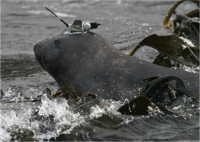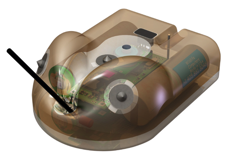
Over 800,000 vertical profiles of Temperature and Salinity have been collected since 2004 in the World Ocean by attaching tags on marine mammals, such as Southern elephant seals.
In this website, you will find information about the marine mammal tagging programs, and an access point to the publicly available databases.
Please let us know if you are using our data. You can contact us by mail to info@meop.net if you have any question.
The MEOP data portal
Content of the website
Wildlife Computer tags
Wildlife Computers develops and manufactures a variety of logger and satellite-relayed tags that are able to continuously measure pressure, temperature and light along the foraging trip of marine animals. The resolution and precision of temperature data is rather low, of order 0.5C, however the spatial resolution can be very high as marine animals tends to dive continuously during extended periods of time. As an example, loggers attached on elephant seals yield datasets made of 60 profiles or more every day with sub-kilometric spatial resolution capability sampled the sub-mesoscale structure of the ocean.
Data loggers such as the TDR-MK9 or TDR10 time-depth recorders (TDR) must be retrieved physically to get access to the measurements sampled during the foraging trip which limits their use to marine animals that have predictible haul-out patterns. The attachment of MK9 and MK10 is common on marine animals such as penguins, fur seals and elephant seals in some location. The MEOP-TDR Database consists in Wildlife Computer TDR data, distributed both in the form of geo-located continuous timeseries and vertical profiles of temperature and light.
Wildlife Computer builds also a family of satellite-relayed tags using the Argos system for transmission, the so-called SPLASH10 tags. These tags use for the moment a low accuracy temperature sensor similar to the ones found in the TDR series, however a new generation of high accuracy CTD sensors may become available in the future. The MEOP data portal does not distribute any SPLASH10 data for the moment, but hopefully this will soon change.

The SPLASH data-archiving tag measures depth, temperature, and light level (©Wildlife Computers 2017)

